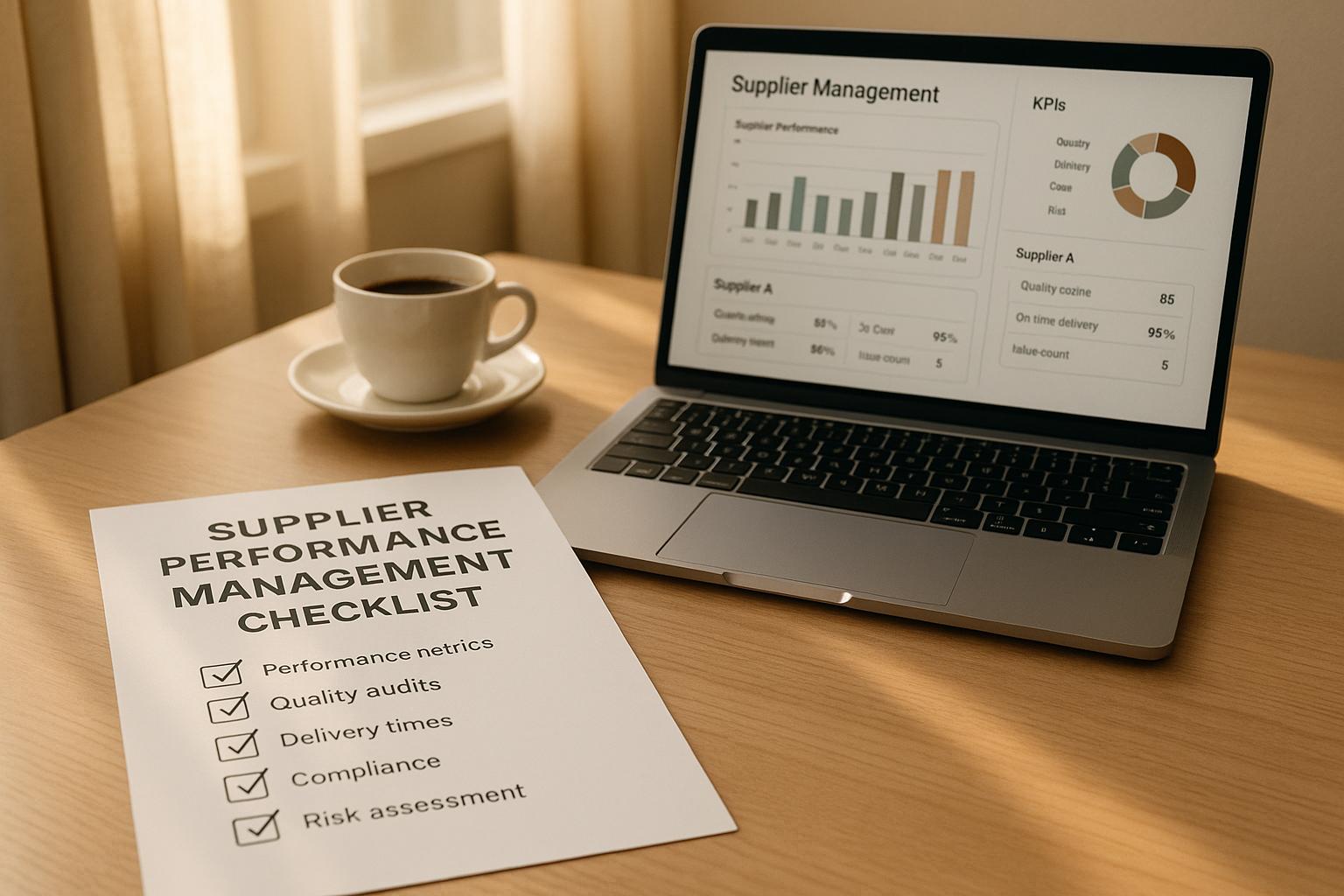
Managing supplier performance can make or break your supply chain. Industries like aerospace, medical devices, and automotive rely on suppliers for quality, compliance, and timely delivery. A single supplier’s failure can disrupt operations, drive up costs, and damage customer satisfaction. Here’s how to stay ahead:
- Set Clear KPIs: Define measurable goals for quality, delivery, and cost. Use both leading (e.g., audit scores) and lagging indicators (e.g., defect rates).
- Leverage Cloud Tools: Automate data collection, track metrics in real-time, and centralize workflows to reduce errors and delays.
- Review Regularly: Hold structured performance reviews to analyze trends, address issues, and align with strategic goals.
- Plan for Improvement: Use findings to create actionable steps, timelines, and measurable targets for underperforming suppliers.
- Ensure Compliance: Verify certifications, traceability, and adherence to strict industry standards like AS9100 or USP Class VI.
Cloud-based platforms like QSTRAT simplify supplier management by automating processes, providing real-time insights, and consolidating data. This approach helps manufacturers maintain quality, meet deadlines, and manage risks more effectively. Investing in these tools can save time and money while improving supplier relationships.
7 Ways to Succeed with Your Supplier Performance Monitoring
Key Criteria for Evaluating Supplier Performance
Setting clear benchmarks is essential for identifying reliable suppliers and addressing issues before they disrupt your operations. These benchmarks also serve as the foundation for a step-by-step evaluation process.
Quality Metrics
Measurable quality standards play a critical role in assessing supplier performance. Two key measures include First Pass Yield (FPY), which tracks the percentage of products that pass quality checks without needing rework, and the Supplier Quality Rating, which combines various quality performance factors into a single score. These metrics are especially important in industries like aerospace and medical devices, where stringent manufacturing and quality control processes are non-negotiable.
Delivery and Timeliness
Timely delivery is a cornerstone of supplier reliability. Evaluate whether suppliers consistently meet agreed-upon deadlines and maintain predictable lead times. A pattern of late deliveries or missed schedules can disrupt your supply chain and hurt customer satisfaction.
Cost and Financial Considerations
A supplier’s financial stability is a critical factor in long-term partnerships. Assess their financial health by reviewing revenue trends, profit margins, credit ratings, debt-to-equity ratios, cash flow, and liquidity. Additionally, consider the risk of bankruptcy.
Suppliers should also carry sufficient insurance to cover potential risks. This includes policies like general liability, professional liability, property insurance, workers’ compensation, product liability, and cyber liability. Proper coverage ensures that unforeseen events won’t derail operations.
Compliance and Certifications
Suppliers must adhere to legal, ethical, and data protection standards while meeting any required environmental regulations. Ensuring compliance not only minimizes risks but also supports consistent product and service quality.
Responsiveness and Communication
A supplier’s ability to respond quickly and maintain clear communication is essential for effective collaboration. Open and timely communication helps resolve issues faster and ensures smoother operations.
Step-by-Step Supplier Performance Management Checklist
Having a clear, structured process ensures you can consistently monitor supplier performance, hold them accountable, and make improvements across your network.
Define Key Performance Indicators (KPIs)
Start by setting measurable KPIs that align with your business goals, focusing on areas like quality, delivery, and cost. Each KPI should have specific targets based on industry standards and your company’s expectations. For instance, aerospace suppliers might aim for zero defects in critical components, while automotive suppliers could prioritize just-in-time delivery with a 99.5% on-time performance goal. Make sure these KPIs are quantifiable and time-bound for accurate tracking.
Incorporate both leading and lagging indicators for a well-rounded view. Leading indicators, such as supplier audit scores or corrective action response times, help forecast future performance. Meanwhile, lagging indicators like defect rates and delivery delays reveal past outcomes. This combination gives you a complete picture of supplier performance.
Once your KPIs are in place, continuously monitor them to identify trends and address potential issues early.
Track and Analyze Supplier Data
Leverage cloud-based tools to automatically gather and analyze supplier data from sources like quality reports, delivery logs, and financial records. Platforms like QSTRAT simplify this by collecting data from multiple points automatically.
Set data collection schedules that match the importance of each supplier. For critical suppliers, daily or weekly monitoring might be necessary, while less critical ones might only need monthly or quarterly reviews. Automating this process reduces manual effort and boosts accuracy.
Use data visualization tools to quickly identify trends and correlations. For example, a supplier with declining quality scores might also experience rising delivery delays. Dashboards that show performance over time can help you spot and address problems before they escalate.
Conduct Regular Performance Reviews
After collecting and analyzing data, hold regular performance reviews to assess supplier results. These reviews are typically scheduled quarterly or semi-annually for key suppliers and should go beyond simply reviewing KPI scores. Include discussions about market trends, capacity challenges, technological advancements, and how well the supplier aligns with your strategic goals.
Prepare clear scorecards to present the data objectively. Highlight trends – whether performance is improving, declining, or staying steady – and provide concrete examples of successes and areas needing attention.
Make these reviews collaborative. Encourage suppliers to share their challenges and offer suggestions for improvement. This open dialogue can strengthen partnerships and uncover insights that raw data might miss.
Provide Feedback and Improvement Plans
Turn the findings from your reviews into actionable improvement plans with clear steps, timelines, and measurable goals. For significant issues, create detailed corrective action plans. For example, if a supplier’s on-time delivery rate falls below 95%, the plan might include upgrading production scheduling systems and providing weekly delivery forecasts.
Don’t just focus on the negatives – acknowledge and reward strong performance, too. Suppliers who consistently exceed expectations should receive positive feedback and potentially more business opportunities. Balancing praise with constructive feedback encourages improvement across your supplier network.
Monitor Progress and Adjust Strategies
Using your cloud-based systems, keep a close eye on progress against KPIs. Don’t wait for the next scheduled review – set interim checkpoints to ensure suppliers stay on track.
Be ready to adjust your KPIs and evaluation criteria as your business evolves. Changes in the market, regulations, or technology may require updates to your performance standards. Regularly assess whether your metrics still align with your goals and industry trends.
Finally, use performance data to guide strategic decisions. Suppliers who consistently perform well could be considered for expanded roles or preferred status, while those with ongoing issues might need to be replaced to protect your operations and customer satisfaction.
Document lessons learned from both successes and setbacks. This knowledge will refine your approach over time and help you manage new supplier relationships more effectively.
sbb-itb-827f251
Using Cloud-Based Tools for Supplier Management
In today’s manufacturing landscape, managing suppliers effectively relies heavily on technology. Cloud-based tools are changing the game, offering manufacturers a smarter way to monitor, analyze, and improve supplier relationships. By automating tedious tasks and providing instant access to essential performance data, these platforms make supplier management more efficient and insightful.
Automation and Real-Time Insights
Gone are the days of manually collecting data from spreadsheets, emails, and scattered systems. Cloud-based platforms like QSTRAT automate the entire process, pulling in quality reports, delivery confirmations, and financial records to update supplier scorecards in real time.
But it doesn’t stop at data collection. These platforms can flag underperforming suppliers automatically when their metrics fall below set thresholds. With automated alerts, procurement teams can address problems immediately instead of waiting for scheduled reviews.
Real-time dashboards further enhance visibility by giving procurement managers up-to-date metrics and trend analysis. This quick access is especially critical in sectors like aerospace and medical devices, where supplier performance can directly affect production timelines and compliance requirements.
Additionally, the platform’s decision support tools use historical data to predict future supplier behavior. This allows teams to anticipate and resolve potential issues before they escalate, ensuring smoother operations. These real-time features pave the way for more efficient workflows, which ties into the next point.
Centralized Data and Workflows
Traditional supplier management often involves juggling multiple tools – quality software, ERP systems, emails, and spreadsheets. Cloud-based platforms simplify this by consolidating all supplier-related data into a single, easily accessible location.
This centralization also extends to workflows. With built-in approval workflows, teams can streamline processes like corrective actions, onboarding, and performance improvement plans. Collaboration becomes seamless as team members work directly within the platform, tracking progress and maintaining a complete audit trail of supplier interactions.
Another standout feature is quoting library management, which stores historical pricing and performance data. This makes it easier to evaluate suppliers during sourcing decisions, giving procurement teams a comprehensive view to make informed choices. The contrast between this approach and manual methods is clear, as shown below.
Cloud-Based vs. Manual Approaches
The advantages of cloud-based tools over manual systems become obvious when comparing their efficiency, accuracy, and scalability:
| Aspect | Cloud Tools | Manual Processes |
|---|---|---|
| Data Collection | Automated integration with real-time updates | Manual entry from various sources, leading to delays and errors |
| Performance Tracking | Continuous monitoring with automated alerts for issues | Periodic reviews where problems may only emerge after causing disruptions |
| Reporting Speed | Instant dashboards with current metrics | Reports generated weekly or monthly, often outdated by the time they’re reviewed |
| Collaboration | Centralized workflows with communication tools | Fragmented communication through email chains and shared spreadsheets |
| Scalability | Easily supports growing supplier networks with minimal effort | Becomes increasingly complex and time-consuming as the number of suppliers grows |
| Audit Trail | Comprehensive digital record of all interactions | Scattered or paper-based records that are difficult to track |
Cloud-based platforms also allow for two-way communication with vendors. Suppliers can update their information, submit performance reports, and respond directly to corrective actions within the system. This streamlined approach speeds up issue resolution and keeps everyone on the same page.
The scalability of these systems is a game-changer for growing businesses. Adding new suppliers is quick and straightforward with cloud tools, while manual processes often become overwhelming as vendor networks expand.
Industry-Specific Best Practices for Supplier Performance
When it comes to manufacturing in high-regulation industries, sticking to general evaluation metrics isn’t enough. Different sectors call for specialized practices to meet their unique challenges. For instance, aerospace and medical device manufacturing demand strict adherence to quality standards and thorough documentation to ensure safety and functionality. Meanwhile, in the automotive world, supplier performance is key to maintaining overall quality and efficiency. These tailored approaches go hand-in-hand with standard evaluation criteria, addressing the specific needs of tightly regulated industries.
Compliance with Industry Standards
Aerospace suppliers operate under some of the strictest certification systems in manufacturing. The AS9100 standard, which builds on the ISO 9001 framework, is a cornerstone for managing quality in aviation and space applications, setting the bar for the industry.
Medical device suppliers face their own set of challenges, especially when materials come into contact with patients. For example, suppliers are often required to provide certificates of analysis (COA) to confirm compliance with safety protocols. This includes ensuring that USP Class VI medical plastics have successfully passed biocompatibility testing.
Across both sectors, meeting recognized quality standards is non-negotiable. Independent certifications not only establish trust but also signal a commitment to ongoing improvement. On top of that, maintaining detailed traceability ensures accountability and reinforces quality control.
Material and Component Traceability
In regulated industries, traceability isn’t just a best practice – it’s a necessity. For medical devices, this means keeping meticulous records to prove that all materials and components comply with safety and certification standards.
Digital tools are making traceability more efficient than ever. Platforms like QSTRAT allow manufacturers to centralize supplier documentation, linking material certificates, test results, and compliance records directly to individual components and assemblies. This digital approach ensures records stay accurate and accessible throughout the entire product lifecycle, simplifying compliance and boosting accountability.
Conclusion and Key Takeaways
By using this checklist, manufacturers can see clear improvements in quality, delivery, and compliance. It offers more than just a list – it lays out a structured approach to boost supplier performance and strengthen supply chain operations. The outlined KPIs, regular reviews, and compliance measures are tailored to meet the demands of highly regulated industries.
Cloud-based solutions are transforming supplier management. QSTRAT’s impressive track record – over $5 billion in RFQs spanning 22 countries – highlights the scalability of digital sourcing. This platform simplifies the entire supplier sourcing process, bringing everything into one integrated system.
Data-driven strategies uncover areas for improvement. Moving away from outdated spreadsheets and email chains, manufacturers can centralize their knowledge and build robust databases to track sourcing events. This not only improves efficiency but also pinpoints supplier improvement opportunities that manual methods often overlook.
These efficiencies lead to smarter financial and operational decisions. Affordability matters, especially for mid-sized manufacturers exploring digital solutions. With five full users costing under $20,000 annually, cloud-based supplier management becomes an attainable investment. The benefits – instant access to supplier responses and advanced decision-making tools – deliver measurable returns through better sourcing outcomes.
For industries like aerospace, medical devices, and automotive, combining structured performance management with digital tools simplifies compliance and operational challenges. Tasks like maintaining centralized documentation, tracking material traceability, and meeting standards such as AS9100 or USP Class VI become far more manageable.
Key Takeaway: Effective supplier performance management is systematic, measurable, and technology-driven. Companies that integrate comprehensive checklists with cloud-based tools can strengthen supplier relationships, mitigate risks, and achieve better supply chain results.
FAQs
How do cloud-based tools like QSTRAT enhance supplier performance management compared to traditional methods?
Cloud-based tools, such as QSTRAT, are reshaping how businesses handle supplier performance management. By automating critical processes and offering real-time data analysis, these tools move away from outdated manual tracking methods, cutting down on errors and saving valuable time.
With features like automated performance tracking, intuitive data visualization, and customizable metrics, companies can make quicker, smarter decisions. This not only helps align suppliers with business objectives but also boosts efficiency in industries like aerospace, medical devices, and automotive.
What key KPIs should companies in regulated industries like aerospace and medical devices focus on to assess supplier performance?
In industries like aerospace and medical devices, where strict regulations are the norm, tracking the right key performance indicators (KPIs) is non-negotiable. These KPIs should emphasize safety, quality, and adherence to compliance standards. Here are some critical ones to keep an eye on:
- Safety metrics: Ensure suppliers consistently meet industry standards and regulatory requirements.
- First Pass Yield (FPY): Measure production accuracy to minimize rework and waste.
- On-Time Delivery (OTD): Monitor reliability and ensure products are delivered as scheduled.
- Cost Per Unit (CPU): Keep an eye on cost efficiency while safeguarding product quality.
- Manufacturing Lead Time (MLT): Gauge how quickly and effectively production processes respond to demands.
- Supplier Quality Rating: Evaluate supplier performance, focusing on defect rates and overall reliability.
- Compliance Rate: Confirm that all operations align with the required regulations.
By regularly reviewing these KPIs, companies can strike a balance between meeting rigorous industry standards and maintaining efficiency and high-quality production.
How do regular performance reviews and feedback help strengthen supplier relationships over time?
Regular performance reviews and feedback are key to nurturing stronger, long-lasting relationships with suppliers. By routinely assessing how suppliers are performing, businesses can pinpoint areas that need improvement, tackle challenges early on, and ensure that quality and delivery standards are consistently met.
When these reviews are paired with open and honest communication, they help build trust and encourage collaboration. This transparency makes it easier to address problems and establish clear expectations. Over time, such efforts not only improve supplier performance but also create dependable partnerships that align with and support business objectives.



